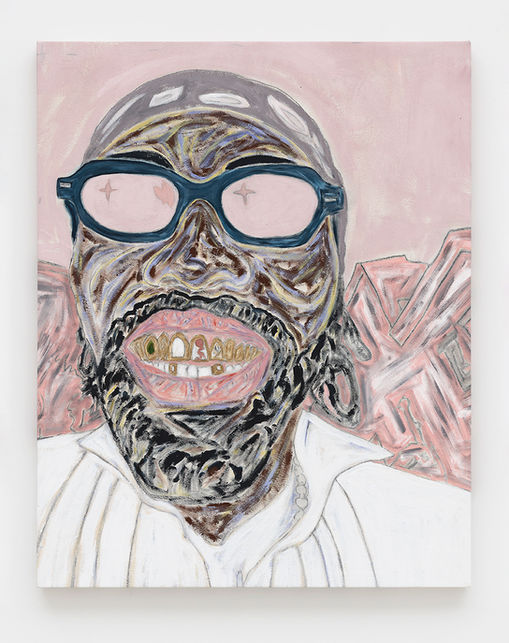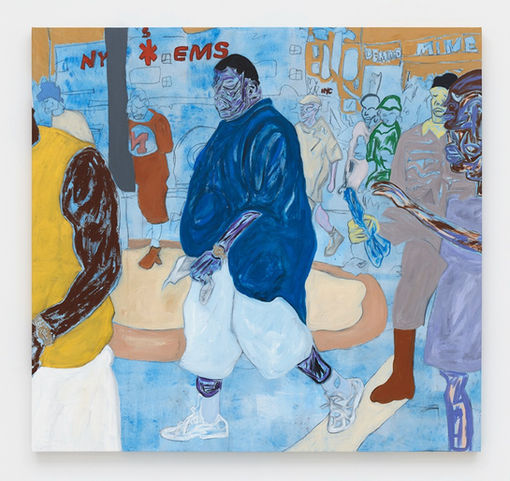SISSÒN
January 13 – 26 2023
December’s twinkling lights and black velvet nights have gone and left us with January, the stiff city cold that runs the spectrum from grayish-brown to brownish-gray. Downtown city people bundle up and brace themselves against the weather, but surrender to the bleak in joyless, mandatory shades of asphalt, pigeon, charcoal and vape.
But at least one artist (and fan) of color has taken on this grim aesthetic by the horns with a new show of work—Sissòn. Though they have been living in Los Angeles for the last three years since giving up their New York apartment during the pandemic, Sissòn has enough icy memories of Manhattan Januarys to give them a painter’s block.
Instead, it gave them a raison de peindre—a reason to paint. And what better canvas than winter, dying to be painted over?
“I wanted it to feel like winter,” says the artist. “But I also wanted to use color to invigorate the idea of winter. People don’t really wear joyful, bright colors—it's just blacks and browns and grays, and they’re like, yep, this is what we're wearing.” But not everywhere, the artist points out. In Black neighborhoods in New York at least, color is Big. And the many colors of all the coats and hats and sweaters and pants aren’t just a way to cover the concrete with a little joy and hope, they form a kind a kind of military resistance to the weathers that be. Is that all you got, February? Because we’ve got Fuschia.
And this is even more personal for the artist, who has experienced synesthesia all their life, feeling and hearing sounds with certain colors. “When I was working on the show, I kept thinking that I wanted to create paintings that might be like Miles Davis playing his trumpet with the mute.”
But then, thinking warmly and creatively is in their blood. Sissòn grew up Glendale, Arizona, about as far away from Phoenix as a suburb could be—they remember riding their bike to a nearby farm to buy milk and eggs. And their young, supercreative mother was an active artist who taught them to paint before they could read.
Despite an enviable head start with oil and canvas, Sissòn didn’t see making art as a career path, and for the few years after high school they ranged in their stints from the dodgy (up to no good) to the dependable (UPS guy), all the while waiting for inspiration to hit. It finally did in the form of fashion; they moved to Los Angeles to study it and stayed to launch their own collection and consult on others, working in Los Angeles, New York and Europe. Ultimately, though, the future called from the past.
And it wasn’t just the six-year-old painter that was burning to get out—they took cues from the kid inside for the content as well. “Many artists don't know what they want to create, but for me, if I felt less-than my whole life because of the lack of representation out there, then I want to shift the paradigm on that. I want a kid that's six years old to go to a museum or gallery and see themselves, like wow, I'm beautiful and we’re beautiful. And I purposely paint the reality of Black people out there. This isn’t just rappers or basketball players, it’s everyone.”
In Sissòn’s latest winter work, they mean specifically everyone who didn’t hibernate in resigned, sorrowful colors. Winter’s punches may leave us black and blue, but there’s no reason we have to stay that way.
– David Colman
Sissòn was born in Los Angeles, California in 1986.
Their recent solo and group exhibitions include “One Way Out” at Franchise Gallery in Los Angeles, California (2022); “Ceramics Synthesized” at Blumenfield Projects in Los Angeles, California (2022); “COTTON (Phase I)” Independent Exhibition in Los Angeles, California (2020); “Rhythm & Blues” at cfcp in Brooklyn, New York (2019); “Men of Change” a Smithsonian Institution Traveling Exhibition to twenty-three museums, including the Contemporary African American Museum in Los Angeles, California; The Charles H. Wright Museum of African American History in Detroit, Michigan; the National Underground Railroad Freedom Center in Cincinnati, Ohio; and the Washington State History Museum in Tacoma, Washington (2018).
Sissòn lives and works in Los Angeles, California.
December’s twinkling lights and black velvet nights have gone and left us with January, the stiff city cold that runs the spectrum from grayish-brown to brownish-gray. Downtown city people bundle up and brace themselves against the weather, but surrender to the bleak in joyless, mandatory shades of asphalt, pigeon, charcoal and vape.
But at least one artist (and fan) of color has taken on this grim aesthetic by the horns with a new show of work—Sissòn. Though they have been living in Los Angeles for the last three years since giving up their New York apartment during the pandemic, Sissòn has enough icy memories of Manhattan Januarys to give them a painter’s block.
Instead, it gave them a raison de peindre—a reason to paint. And what better canvas than winter, dying to be painted over?
“I wanted it to feel like winter,” says the artist. “But I also wanted to use color to invigorate the idea of winter. People don’t really wear joyful, bright colors—it's just blacks and browns and grays, and they’re like, yep, this is what we're wearing.” But not everywhere, the artist points out. In Black neighborhoods in New York at least, color is Big. And the many colors of all the coats and hats and sweaters and pants aren’t just a way to cover the concrete with a little joy and hope, they form a kind a kind of military resistance to the weathers that be. Is that all you got, February? Because we’ve got Fuschia.
And this is even more personal for the artist, who has experienced synesthesia all their life, feeling and hearing sounds with certain colors. “When I was working on the show, I kept thinking that I wanted to create paintings that might be like Miles Davis playing his trumpet with the mute.”
But then, thinking warmly and creatively is in their blood. Sissòn grew up Glendale, Arizona, about as far away from Phoenix as a suburb could be—they remember riding their bike to a nearby farm to buy milk and eggs. And their young, supercreative mother was an active artist who taught them to paint before they could read.
Despite an enviable head start with oil and canvas, Sissòn didn’t see making art as a career path, and for the few years after high school they ranged in their stints from the dodgy (up to no good) to the dependable (UPS guy), all the while waiting for inspiration to hit. It finally did in the form of fashion; they moved to Los Angeles to study it and stayed to launch their own collection and consult on others, working in Los Angeles, New York and Europe. Ultimately, though, the future called from the past.
And it wasn’t just the six-year-old painter that was burning to get out—they took cues from the kid inside for the content as well. “Many artists don't know what they want to create, but for me, if I felt less-than my whole life because of the lack of representation out there, then I want to shift the paradigm on that. I want a kid that's six years old to go to a museum or gallery and see themselves, like wow, I'm beautiful and we’re beautiful. And I purposely paint the reality of Black people out there. This isn’t just rappers or basketball players, it’s everyone.”
In Sissòn’s latest winter work, they mean specifically everyone who didn’t hibernate in resigned, sorrowful colors. Winter’s punches may leave us black and blue, but there’s no reason we have to stay that way.
– David Colman
Sissòn was born in Los Angeles, California in 1986.
Their recent solo and group exhibitions include “One Way Out” at Franchise Gallery in Los Angeles, California (2022); “Ceramics Synthesized” at Blumenfield Projects in Los Angeles, California (2022); “COTTON (Phase I)” Independent Exhibition in Los Angeles, California (2020); “Rhythm & Blues” at cfcp in Brooklyn, New York (2019); “Men of Change” a Smithsonian Institution Traveling Exhibition to twenty-three museums, including the Contemporary African American Museum in Los Angeles, California; The Charles H. Wright Museum of African American History in Detroit, Michigan; the National Underground Railroad Freedom Center in Cincinnati, Ohio; and the Washington State History Museum in Tacoma, Washington (2018).
Sissòn lives and works in Los Angeles, California.
















